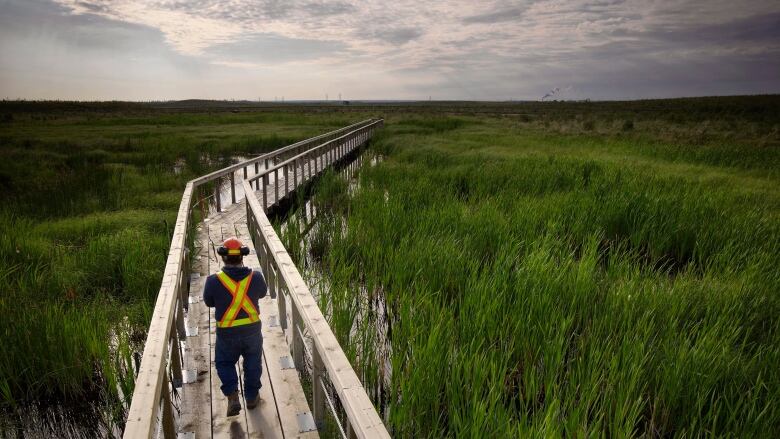'We can't replace nature': Oilsands wetland reclamation a mixed success
'It's probably going to be centuries before these systems become indistinguishable from natural systems'

The challenge makes turning bitumen into oil seem likethe easy part.
Faced with reclaiming open-pit mines that were once thrivingwetlands, Suncor and Syncrude have been trying to do what's neverbeen done rebuilding one of the most complex, diverse and delicateecosystems in the boreal forest.
Three years into the ground-breaking, high-profile projects,early successes are emerging.
Suncor's Nikanotee fen and Syncrude's Sandhills fen are stayingwet year-round. They're growing some typical fen plants. Evenbetter, they've begun to store carbon in their peaty depths.
"(That's) one of the core functions of a fen ecosystem, sothat's really great," said Joshua Martin, Suncor's wetlandreclamation director.
We can pour all this money into a fruitless reclamation attemptor ... turn around and take that money and do something really goodwith it.- LeeFoote
But the overall plant mix isn't what it was. Soil and waterchemistry has changed. Biodiversity has shrunk.
The fens don't seem to be developing into what was there beforeand nobody really knows how they will evolve.
"We can't kid ourselves," said Jonathan Price of the Universityof Waterloo, one of the main experts behind Nikanotee. "We can'treplace nature."
Fen recovery is so uncertain and expensive that one researchersuggests resources would be better used elsewhere.
"It's useful for scientists, but I don't think it's cost-effective over large areas," said the University of Alberta'sLee Foote, who was involved with the projects for years beforestepping back.
"We can pour all this money into a fruitless reclamation attemptor ... turn around and take that money and do something really goodwith it."

Fens are wetlands that are permanently waterlogged with analkaline, peaty soil that stores vast amounts of carbon. They filterwater and store it during dry years and are considered essential tothe boreal ecosystem.
They are widespread throughout Alberta's boreal forest and arethought to have originally covered more than half the combinedleases of Suncor and Syncrude.
Suncor has promised to restore about one-fifth of the more than100 square kilometres of wetland it plans to disturb. The companyhas only committed to the Nikanotee fen, which covers about 10hectares.
They are, after all, finicky.
"Not too wet; not too dry," said Dale Vitt, one of the expertsadvising Syncrude. "This sweet spot is where the fen plants comein."
The water table is controlled by the contours of the land aroundand the layers of soil and rock underneath. In the oilsands, thatlandscape has to be completely rebuilt.
Only parts of Sandhills are working, acknowledged Vitt ofSouthern Illinois University.
Where the water is right, fen plants are burgeoning. But overall,fewer than half the species in Sandhills are desirable species. Onearea is turning into a poplar forest.
As well, both fens have been built atop a layer of leftover sandthat's had the bitumen removed. That's creating problems as sodiumand calcium from the sand leaches into the fens.

Neither Sandhills nor Nikanotee are as salty as some naturalfens. The amount of sodium in the water changes the mix of plantsthat will grow.
"We're still not at the mix of plants that we see in those(natural) systems," said Price. "But it's early in the game.
"It's probably going to be centuries before these systems becomeindistinguishable from natural systems."
Neither Syncrude nor Suncor have released the budgets for theirpilot projects. Both companies say they're committed to monitoringtheir fens for years to come.
Foote suggests at least some of the value of the fens has nothingto do with ecosystems.
"There is such a tremendous appetite for some good news storiesin the oilsands," he said. "There's a lot of optics and imagemanagement here.
"A lot of promises and attempts were made in order to get sociallicence and regulatory licence to get their permits approved. Theypromised these things and they got their licence."
It's probably going to be centuries before these systems become indistinguishable from natural systems.- Jonathan Price
Alberta is almost half boreal forest, of which about .002 percent has been affected by the oilsands, and it has a lot of fens.
Fens are always going to be too expensive and difficult forlarge-scale restoration, said Foote. The money being spent onNikanotee and Sandhills which he estimates in the tens of millions of dollars might be better spent on other problems.
"I would rather see the government get the support dedicatedtowards other habitat maintenance."
But Price said fens are crucial in the boreal forest, storingwater through dry years that desiccate other types of wetlands.
"We're not going to be able to put fens back to cover the samearea that there was originally. But the idea is to put enough ofthem back so some of the biodiversity is ultimately achieved."












_(720p).jpg)


 OFFICIAL HD MUSIC VIDEO.jpg)
.jpg)



























































































